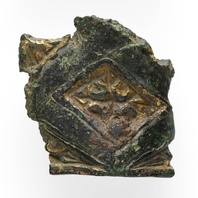
Viking Objects
Broken Gilt Vessel (CM.1822.2008)
A broken gilt vessel fragment decorated with a Carolingian motif within a repeated diamond pattern. A single iron rivet provides evidence that this vessel might have been repaired and reused. The vessel will have been brought from Francia to Torksey, Lincolnshire, where it was found, perhaps by a member of the Great Heathen Army or its train.
Read More
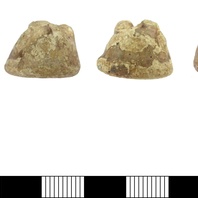
Viking Objects
Cast Lead-Alloy Gaming Piece (DENO-646EE0)
A complete cast lead-alloy early medieval gaming piece. This and similar pieces have also been interpreted as weights although the gaming piece interpretation is more secure. Pieces like this would have been used to play hnefatafl and/or Nine Men’s Morris, both of which are known to have been played in Scandinavia in the Viking Age.
Read More
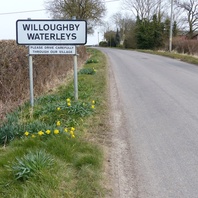
Viking Names
Willoughby Waterleys
Willoughby Waterleys, in the Guthlaxton Hundred of Leicestershire, is an Anglo-Scandinavian compound from Anglian wilig ‘a willow-tree’ and Old Norse by ‘a farmstead, a village’. This is a common hybrid place-name and in most cases of usage it is a Scandinavianized form of Old English wiligtun ‘farmsted or village where the willows grow’. Some names of this type may conceal the Old English wiliga-beag ‘a circle of willow-trees’. Willoughby is a well-watered parish and lies on gravel and clay between two arms of the Whetstone Brook and has many large pools in its vicinity. Therefore its affix Waterleys from Old English leah ‘a forest, wood, glade, clearing; (later) a pasture, meadow’ and Old English wæter (Old English) ‘water, a river, a lake’ is appropriate. The affix was likely added at a later date to distinguish this Willoughby from Willoughby on the Wolds just beyond the Nottinghamshire boundary to the north.
Read More
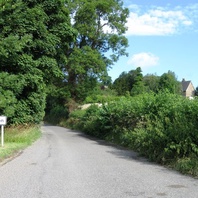
Viking Names
Kirk Ireton
The first element of Kirk Ireton, in the Wirksworth Hundred of Derbyshire, is the genitive singular or plural of the Old Norse ethnonym Íri, ‘an Irishman; probably also a Norseman who had lived in Ireland’ combined with the Old English element tun ‘an enclosure; a farmstead; a village; an estate’. Old Norse kirkja ‘a church’ was affixed at a later date. Traditionally, the place-name has been interpreted as referring to a settlement of Irishmen; probably Norsemen who lived in Ireland. However, the exact implications of such a name are not yet fully understood and are the subject of ongoing work by Dr Jayne Carroll of the Institute for Name-Studies, University of Nottingham.
Read More

Viking Names
Toki
Tóki is either a short form of names in Þórkell or possibly a pet-form of name in Þór- ‘the god’s name Þórr’ with the addition of the suffix -ki. The name is very common in Denmark where it is found in many place-names. It possibly spread to Norway and Sweden from Denmark. It is fairly common in Sweden in the forms Toke and Tuke and in Norway from the eleventh century onwards, but it is very rare in Iceland. In Normandy it is probably found as the surname Tocque and occurs in a number of place-names there. The personal name is also the first element in Tugby, Leicestershire.
Read More
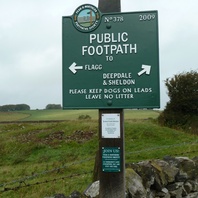
Viking Names
Flagg
Flagg, in the High Peak Hundred of Derbyshire, is a simplex place-name perhaps from the dative plural form (-um) of Old Norse flag ‘a turf, a sod’ with the meaning ‘place where the turfs were cut’.
Read More
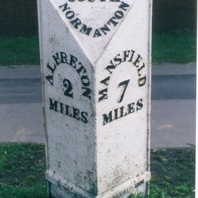
Viking Names
South Normanton
South Normanton, in the Scarsdale Hundred of Derbyshire, takes its name from the Old English ethnonym Norðman ‘Northman, Norwegian’ and the Old English element tun ‘farm, settlement’. There are several places of this name, predominantly in the East Midlands: five in Nottinghamshire, also others in Derbyshire, Leicestershire, Lincolnshire and Rutland, and one in the West Riding of Yorkshire. The prefix South distinguishes it from Temple Normanton, formally North Normanton. Traditionally, the place-name has been interpreted as referring to a settlement of Norwegians (in an area where most of the Scandinavian settlers were Danes). However, the exact implications of such a name are not yet fully understood and are the subject of ongoing work by Dr Jayne Carroll of the Institute for Name-Studies, University of Nottingham.
Read More
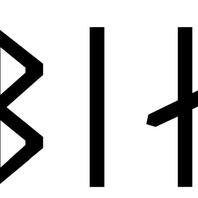
Viking Names
Asbjorn
Ásbjǫrn was a common name in Norway from the time of the settlement of Iceland (c. 870-930) onwards, and is common in Swedish and Danish runic inscriptions. Forms in Æs- are very common in Denmark and a few runic forms likely represent these spellings. Additionally there are numerous instances of the form Osbern found in Normandy which are possibly loans from England. It is a Old Norse compound name with the first element, Ás-, from Old Norse ás, óss ‘a god’, combined with bjǫrn, ‘bear’. It was common for Viking Age Scandinavian personal names to use animals as name-forming elements. Several place-names in Lincolnshire and Yorkshire may include the Low German male personal name Osbern, although the name is more likely to be an anglicised form of Old Norse Ásbjǫrn, as in Osbournby in Lincolnshire, and the name is also recorded in medieval documents from both Lincolnshire and Yorkshire.
Read More
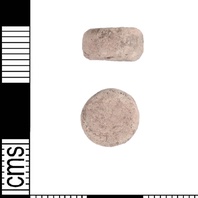
Viking Objects
Round Lead Weight (PUBLIC-2DDD03)
Weights are an important form of evidence for Viking Age commerce and the use of standards across the different economic systems within which Vikings were integrated. Many of the weights discovered, particularly ones in Ireland and those of Arabic type, suggest that a standardized system of weights existed in some areas. These standard weights, alongside standard values of silver, are what allowed the bullion economy of Viking occupied areas to function. A bullion economy was a barter economy that relied on the exchange of set amounts of precious metal in various forms, such as arm-rings or coins, for tradable goods, such as food or textiles. Each merchant would have brought their own set of weights and scales to a transaction to make sure that the trade was conducted fairly.
Read More
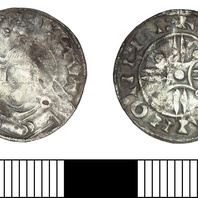
Viking Objects
Coin of Cnut the Great (DENO-28F8A6)
This silver penny is a posthumous issue of Cnut, with arm and sceptre obverse type, minted by Thurgrim in Lincoln under the authority of King Harthacnut. Minting coins was a way of controlling the means of exchange within a kingdom and which created a more easily administered standardized system of trade. Moreover, the coins themselves were often used as propaganda, portaying symbols and statements that gave off a desired message. The Vikings later used the minting of coins to legitimize their own rule.
